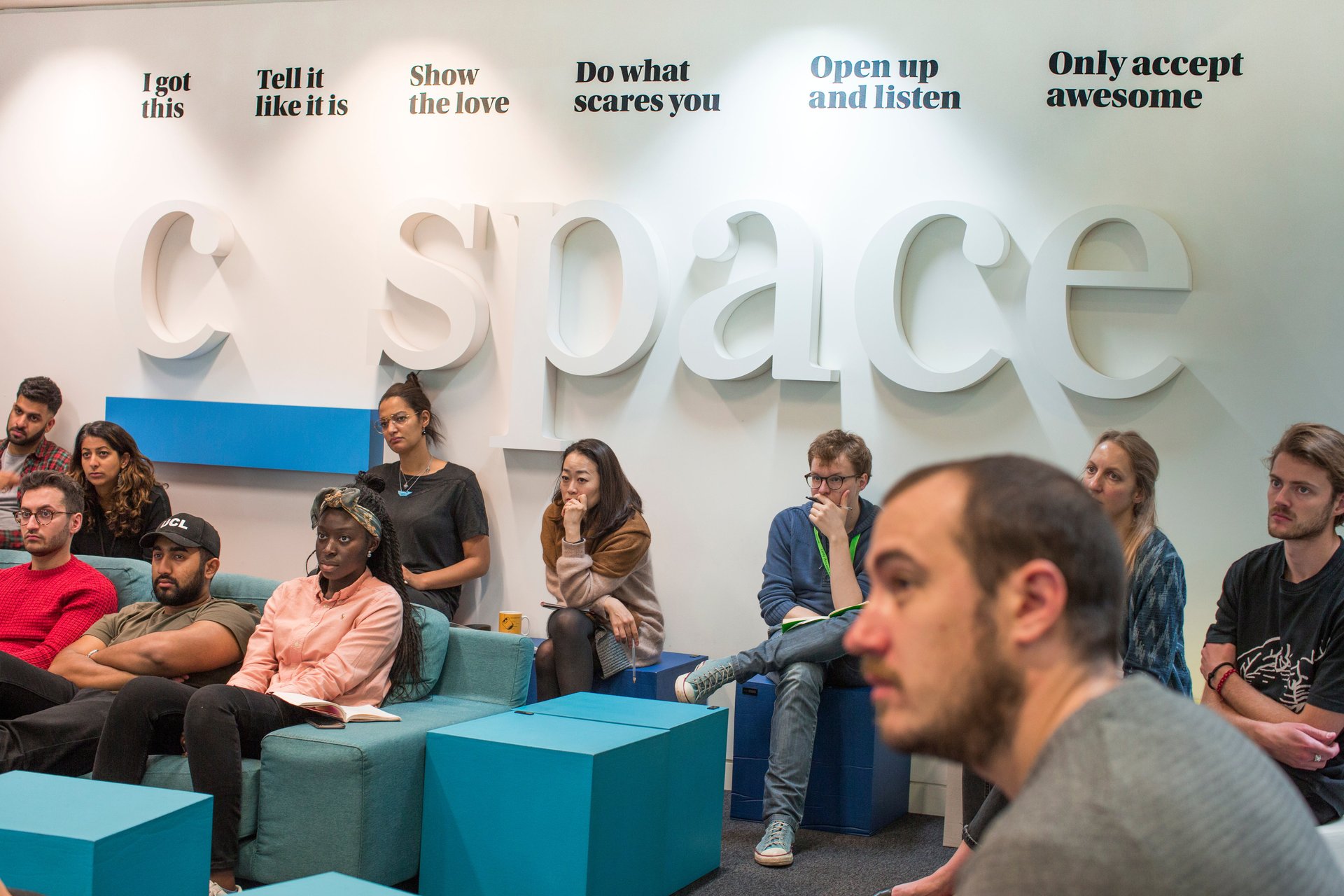The surprising fragility of a powerful perk: company culture
Human beings cannot interact without developing a culture. Wherever we flock together, we wordlessly build codes of conduct, hold each other up to unspoken expectations, and quietly define the emotional life for the group.


Human beings cannot interact without developing a culture. Wherever we flock together, we wordlessly build codes of conduct, hold each other up to unspoken expectations, and quietly define the emotional life for the group.
The phenomenon is as stark at the office as anywhere else. But the alchemy that makes one workplace supportive and another a daily psychodrama is still not totally understood.
It’s a riddle companies are desperate to solve, and with good reason. Researcher Luigi Zingales, a professor of finance at the University of Chicago Booth School of Business, has shown that a strong company culture, defined as one in which employees say that managers live the values they espouse, is tied to better long-term performance. A strong culture also makes it easier to hire and keep talented people in a competitive market.
Culture matters deeply to employees. In a recent survey of more than 3,000 Americans, 70% of respondents said they would turn down a job offer at a leading company if they knew the culture was lousy, and 65% said the promise of better pay at such a firm would not even be tempting.
This is the story of how one company, C Space, attempted to solve the riddle of a strong culture in a more methodological way than most, first running an “audit” on its existing culture, then boiling down the fixes it needed to memorable mantras, and finally setting these new values loose in a successful course-correcting effort. And how, even though it followed the textbook-recommended formula, all of this work still backfired. And how, eventually, the company found a more sustainable way to create the culture it wanted.
The culture crisis
Today, C Space is a Boston-based company with offices in London, New York, Mexico City, San Francisco, and Shanghai. In its own corporate parlance, it works with consumers to “co-create” new products for major brands, rather than working with brand to impose a new product on buyers. Past clients have included British Airways, Heinz, Bank of America, and Samsung.
But C Space started out as a smaller firm called Promise. Founded in 2000 by a longtime ad man and a psychologist in London, its big idea was to draw from the methods of psychoanalysis to get inside a consumer’s mind and access some previously unarticulated itch.
The firm was inspired to audit its own culture—using some of the very same methods it used with clients—after the advertising giant Omnicom acquired the company in 2012. Omnicom, with its sleek offices and free breakfasts, had a culture that was foreign to that of the scrappy (former) startup. And on top of that, it promptly merged Promise with another Boston-based company it had acquired, which meant that while all of Promise previously had been able to crowd into the same room, its employees were now part of C Space, a sizable company. The sense was that something intangible was lost.
By 2015, C Space’s growth dipped for the first time in the firm’s history. Phil Burgess, then one of C Space’s managing directors in London, now chief people and operations officer in Boston, felt it was time to read the room, so to speak, so he ran an employee survey, and found that among a staff of then just under 100 people, only 56% felt proud to work for the company. One in three employees had left by the end of the year. “There was the general feeling that every problem was someone else’s problem now,” Burgess says.
The culture audit
To exorcise the new demons, Burgess launched a “culture audit,” appointing employees from different parts of the business, and at various levels of seniority, to a group that would represent the populous and diagnose what was happening, and then fashion a recovery plan. Following the advice of organizational behavior experts, they wouldn’t gin up elusive values like “excellence” or “integrity.” Rather, they would focus on specific ideas that would be memorable, actionable, and frequently invoked to guide day-to-day business.
C Space was perhaps especially well-prepared to develop a list of values through a process like this one. Its specialty, after all, is diagnosing its clients’ challenges through “co-creation” techniques. One of its signature exercises is called “clear the path,” when its consultants ask their clients’ customers to go ahead and rant for 60 seconds. What drives you nuts about this telephone company? The customer service? The hidden charges? Let it out. The goal is to expose all the issues that are bothering people about a situation or a brand, and then in turn to encourage creative thinking and a constructive mindset in the quest for solutions.
Another C Space exercise asks people to literally draw their feelings, without using stick figures or anything representational, but instead keeping their artwork abstract, collectively crafting a gallery of emotions that are posted on a wall. Or customers might write a “Dear John” letter to a brand they once loved, explaining why it was time to break up.
A third trick involves guided visualization: “We get people to shut their eyes and it’s a bit like meditation,” says Burgess. “You actually just paint a picture of a world. You say, ‘Imagine it’s three years in the future. This is what happened.’”
Now C Space applied these tools to its own culture, for instance, imaging what the team might find written about its culture in a future article. Like this one.
When members of the C Space culture task force “cleared the path” in this way, first consulting with employees in their own departments and then bringing what they heard and felt themselves to the group, some of what came to light pointed to material problems. The London office didn’t have an HR department. Maternity and paternity benefits weren’t generous enough. Employees worried about the ways in which the company was spending its money.
But then the questioning went deeper. By Burgess’ account, it included, “What’s all the stuff that annoys you about leadership? When you’re looking at your colleagues, what are the things they do that the frustrate you? What are the toxic elements of our culture?” Next, the task force asked people to reflect on the ways they probably frustrated their co-workers.
After several rounds of fine-tuning, the culture committee members identified the norms, values, and behaviors they wanted to encourage:
- I’ve got this.
- Only accept awesome.
- Show the love.
- Do what scares you.
“I’ve got this,” would nudge employees toward full ownership of a task or problem that needed solving and discourage passing the buck. “Only accept awesome” was a reminder that the firm had to wow its clients, leave them amazed, not merely satisfied. “Show the love” was a more evocative phrase for “be kind to each other,” and make a point of acknowledging your peers’ work before rushing on to the next job. Finally, “Do what scares you” was a battlecry against complacency, a call to take responsibility for your professional growth.
Meet the behaviors
When the behaviors were ready for their debut, the culture audit group stood before the staff and each member told a story, a kind of confession, related to one of the statements. “A senior person shared a story of how they were working with someone junior on a deliverable for a client, and they could see that that junior person was struggling a bit, but they just wanted to get home,” says Burgess, and they did. “They knew deep down that person was going to be set up for a late night.”
They had not shown the love.
Another employee said they’d left one day instead of staying 10 minutes to reread a report. “The impact of that was the next day, the client called up, all of our team got dragged across the coals,” this person said. The company’s reputation was dinged, as was that employee’s, and team morale sank.
The moral of the story? Only accept awesome, obviously. (Also, the proofing task was his responsibility, so where was his “I’ve got this”?)

At first, the new models worked. Within a year or so, says Burgess, people were taking ownership of issues, and employees fretted more about the quality of their work. The behaviors purged the air of bad mojo, and they appeared on the rubric used to measure employee performance, tying each one to someone’s ability to be promoted and be rewarded. They carried weight.
Every Friday, at an all-hands meeting, managers would give shoutouts to employees who had demonstrated a particular behavior. They built an “I got this” board, so if a manager wanted to issue a challenge to do something like start a book club, they could put it on the board, and then ask, “Who’s got this?”
It was often junior people who would raise their hands, which was progress. Employees are more likely to feel content, and not quit, when they feel engaged. “So ‘I got this’ became like a mechanism for getting stuff done, and creating opportunities,” says Burgess.
But, like most rules meant to apply to a specific situation, these ones didn’t translate well to other areas.
Intention vs interpretation
About a year after the behaviors were created, ugly new patterns emerged, not despite the behaviors, but because of them.
Maybe it was their extreme pithiness that left too much room for subtext, or their newfound power as performance metrics, but the behaviors began to take on sinister undertones.
In meetings, for instance, “showing the love” became an opportunity to curry favor with managers. By encouraging obsequiousness, the practice also killed honest feedback. During exit interviews, C Space’s managers would learn that the reason some people were leaving was because they didn’t receive enough constructive criticism. Sometimes people were shown love for just doing their jobs, says Benjamin Moncrieffe, an account director who was part of the first culture audit group. That wasn’t the point, either.
The praise bestowed on anyone who “got” something became an addictive drug to many employees, especially because that praise was directly connected to status. Worse, junior staffers, especially, began to fear that not “getting” several chores could hold up their careers. They needed to own it all. More than once, says Burgess, a client called up to discuss a concern, but reached a junior member of the team who was blinded by “I got this.” The issue didn’t get escalated to the appropriate person because that straight-out-of-university employee had it covered.
Senior folks weren’t innocent, either. They would see a junior colleague taking control of a project and would decide not to intervene, on the pretense that they were empowering a less-experienced co-worker.
And “do what scares you”? “I don’t think we recognized how difficult it might be for some personality types to ‘do what scares you,’” says Moncrieffe.
Of all the behaviors, “only accept awesome” was probably the most destructive. It came to be read as “work until you’re exhausted,” never pushing back, even with an over-demanding client whose needs, per their contract, had already been met or exceeded.
It was around this time that an executive overheard two account managers bragging about their work ethic. “That’s nothing,” said one. “I once held my pee all day.”
For the record, this is not a laudable display of mind over nature. Holding your pee may not kill you, but medical experts say it can create the conditions for bacterial growth and a urinary tract infection, or eventually weaken your bladder muscles if it becomes a habit. It’s an undeniably maladaptive response to a heavy work load.
The cultural fabric was now warped—again. While the behaviors had cured the apathy problem, they had created a cult-like devotion to work that the staff grew to resent.
The realignment
It may sound strange given recent revelations about Facebook’s management tactics and corporate citizenship, but it’s possible that borrowing Facebook CEO Mark Zuckerberg’s formula for creating company values may have saved C Space some grief. Zuckerberg once explained on Reid Hoffman’s Masters of Scale podcast that he believes an organization’s values should reflect not just what the group wants to do, but what it is ready to give up. “Move fast,” for example, one of Facebook’s early values, required sacrificing perfection in the code, he said. (Of course, critics would say this supernova-style expansion de-prioritized more than just flawless software.)
On the face of it, choosing to elevate an idea like “I’ve got this” may seem wholly positive, but three words can’t capture much nuance. It’s not surprising that employees might mentally downgrade the possible flip-side behaviors, like collaboration and personal wellbeing.
Hindsight always helps: Uber’s original 14 values—including “always be hustlin,” now read as much like a playbook for building a coalition of jerks as a guide to launching one of the hottest startups in history. When Dara Khosrowshahi took over as Uber’s CEO last year, he scrapped the company’s founding values. C Space didn’t want to go this route. Instead, in a new attempt to fix the fury brought on by the work of the first culture committee, its leadership put together a second culture committee, this one comprised of some original members of the behaviors-writing group and some who were new to the process.
The new committee introduced two new behaviors, this time in a more top-down process. They are “Open up and listen” and “Tell it like it is,” and they’re meant to counterbalance any urge to go overboard with the love, or watch someone struggle alone, or feel afraid to ask for help. They support feedback.
Also, C Space rewrote the competency frameworks that were incorporated in employee reviews to make it clear that although showing initiative is applauded, so is knowing you’re not invincible.
Things have improved, says Shreeya Patel, a senior consultant and one of the second culture committee’s rookie members. For her, the two new behaviors have come in handy when she has had to broach a topic with someone she doesn’t know well. ”If I don’t have an open relationship with someone, I’ve signaled that I’m going to tell it like it is, or I’m going to open up and listen, and that’s a nice way to open a conversation,” she says.
Still, even “tell it like it is” could be corrupted, she points out. It might lead someone to believe that they don’t have to be considerate when they speak. “Only accept awesome” also needs further recalibration, she says. It can feed competitiveness, when someone wants to believe that they’re more awesome than someone else.
Employees need to understand that there are many ways to be awesome, including knowing how to analyze a situation and accept that the work is done, she notes. It’s hard to squeeze this variation into a short mantra.

Part of the culture team’s mission is to continuously “unpack” the behaviors and their intentions, especially as new employees come on board. In the end, though, Patel believes it’s not the content of the behaviors that has improved the atmosphere and energy at the company. It’s that the behaviors exist at all. “I mean, it’s the happiest I’ve been in a workplace,” she says, “I think a lot of it’s to do with the values, but not necessarily the words, or what the values actually are. I think it’s really that we have them, and we have leadership who is dedicated to them.”
A better path
In the most recent employee survey at the London office, conducted a few weeks ago, Burgess was pleased to find results that were far rosier than in 2015. The survey showed that 96% of London employees say they know how their role contributes to the business, and 92% are passionate about delivering excellent client work. The same number believe the company has a strong culture.
Even more telling: In 2017, the firm’s attrition rate in London was about 17%, down from 30% in 2015, and three points lower than the industry average.

Business is also brisk again, back to double-digit growth. Burgess allows that this may be partially thanks to a stronger economy, but he also believes the behaviors, and their redux, unlocked creativity and drive. He compares the process of shaping a culture as “a bit like a pendulum,” saying, “You can go a little bit too far one way and they recognize it and then bring it back a bit.”
But not everyone at C Space is convinced that the pendulum has swung back into reasonable territory. On Glassdoor, a few of the negative reviews from the Boston location suggest the company may be understaffed, and that junior people are still more or less left to fend for themselves. The are some glowing descriptions of life at the agency, but there’s also:
“High turnover, long hours, little management or training.”
“This company is a revolving door, which leaves teams very understaffed and overworked.”
The American office has added “Put we before me” and “Leave a mark” to the behaviors list it inherited from London. One Glassdoor reviewer called the behaviors “propaganda-like,” stating:
One of them is “Put we before me” which often translates there as “Why don’t you work later to do this last minute report?” Forget trying to manage your time – they will twist your words and view you as not being a team player. Or “Do What Scares You” meaning doing something we didn’t adequately train you (or hire you) for.”
Robert Quinn, professor emeritus of management at University of Michigan, says that understanding what went wrong in a situation like C Space’s may mean looking to management: How do they interpret the behaviors? And are any of the leaders engaging in some extreme behaviors that would contradict the intentions that underly the list? What does the company do during a crisis, when it may be inconvenient to adhere to its stated values?
In recent years, Burgess says, it’s true that some senior leaders may not have been walking the talk. For instance, he recently had to speak to one manager who, once again, did not take a vacation all year, but intends to take a break only at the year’s end. At the same time, he says, the leadership team may have missed opportunities to celebrate quietly positive behaviors, and has probably become a bit lazy about shout-outs, period.
Burgess is aware of the negative Glassdoor evaluations, but he argues that the Boston office hasn’t had as much history with the behaviors, and that there’s work to be done.
Let the next iteration of the culture audit begin.
Editor’s note: An earlier version of this story misstated the year for the Omnicom merger. It has been corrected.